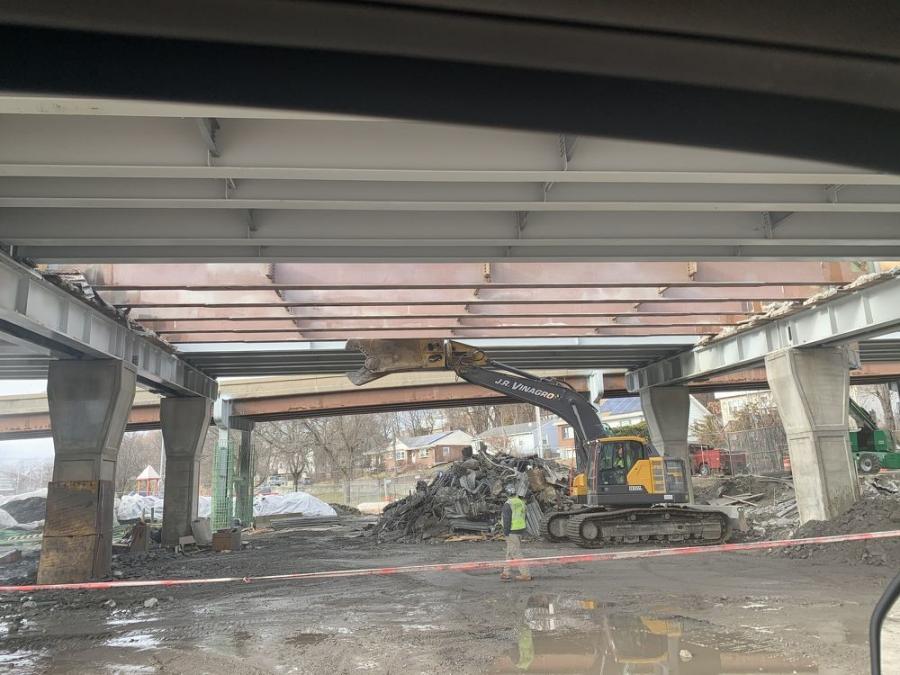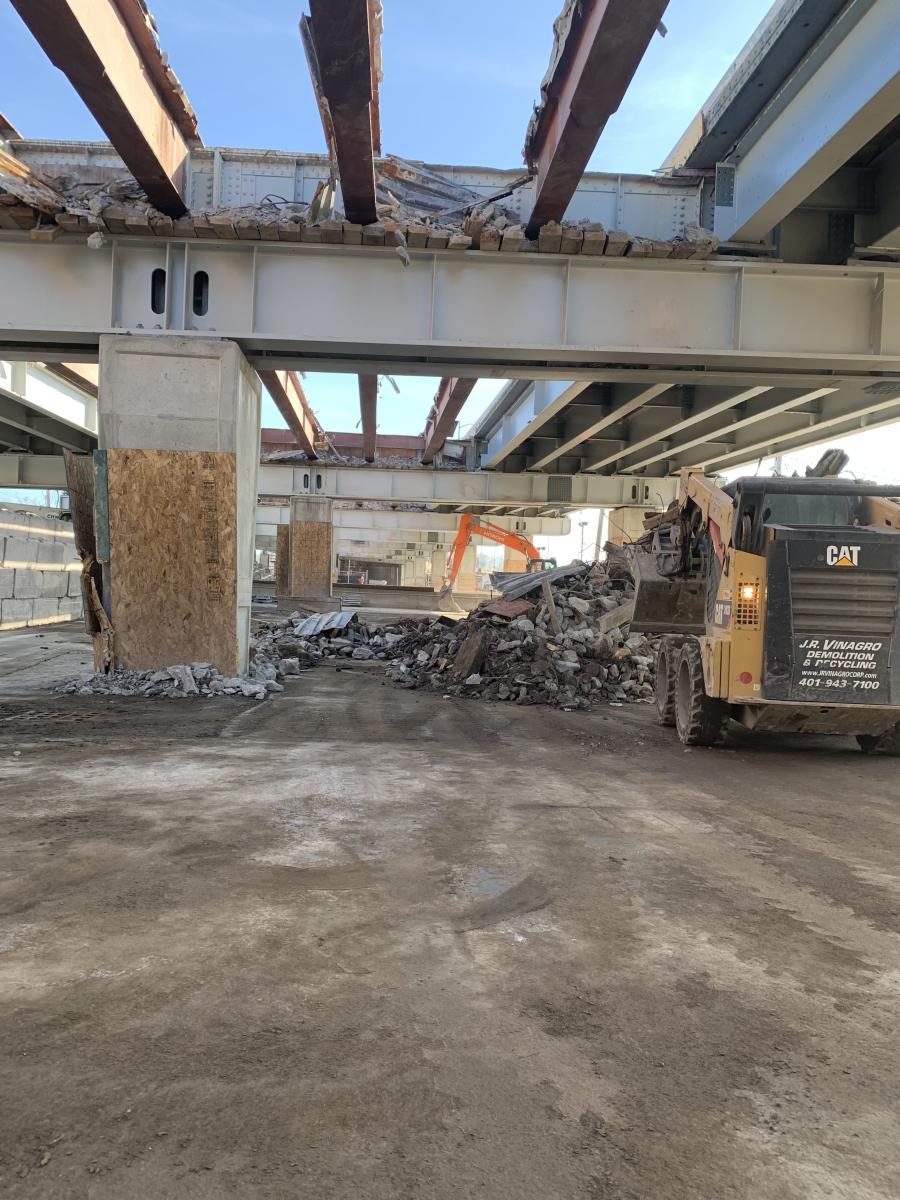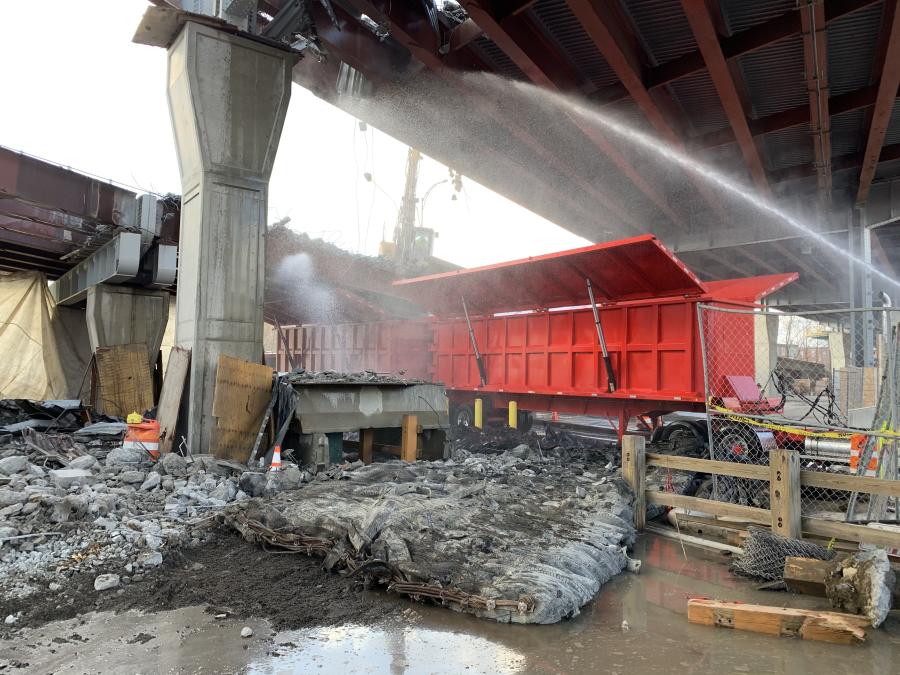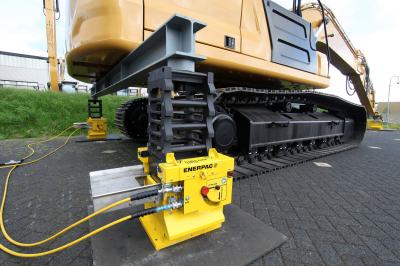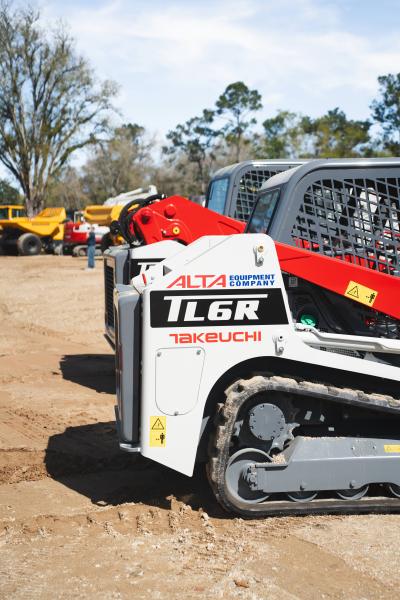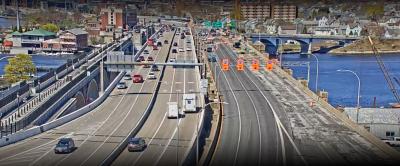J.R. Vinagro Corporation was hired to demolish the viaduct and removal of all the concrete and steel beams from the work site.
(J.R. Vinagro Corporation photo)
The Skanska-McCourt Joint Venture (Skanska US and McCourt Construction Co.) started its work on the Massachusetts Department of Transportation's (MassDOT) nearly $204 million (total cost) rehabilitation of the Chelsea Viaduct Bridge in Boston, a project that began in April 2019.
The construction cost, via the contract awarded to the JV, is $169 million.
The bridge, constructed between 1956 and 1957, carries Route 1 over the "Chelsea Curves" from County Road Overpass to the Tobin Bridge, spanning Fifth Street, Arlington Street, MBTA Commuter Rail, Spruce Street, Carter Street and Orange Street in Boston's Chelsea district.
The work has crews repairing and retrofitting the substructure, using pre-fabricated bridge units (PBUs) throughout the majority of project, as well as using conventional repair methods at six isolated spans; building new crash tested bridge barriers and a solid snow fence; replacing roadway lighting and bridge drainage; rebuilding existing parking lots under the viaduct and adding a new Carter Street lot; and the reconstruction of all approach roadways and the rehabilitation of the Tobin Bridge upper deck, including paving, over Chelsea Local Streets and Mystic River that was originally included in the ongoing Tobin Deck Rehab contract.
A key aspect of the work is replacing the exposed metal bridge supports with metal supports encased in concrete that are attached to a metal beam that goes across the substructure.
The ongoing substructure rehabilitation should be completed in the spring and the superstructure replacement, which follows, will be finished sometime in the fall. There is a possibility that the final restoration and delivery date of July 2021 may be extended to the end of the year. The schedule has been coordinated with Tobin Deck Rehabilitation and other regional projects.
"The rehabilitation of the Chelsea Viaduct is a critical step toward meeting MassDOT's bridge condition goals and improving safety," stated a MassDOT board of directors report on the project. "When completed, [it will] will reduce our Deck Area rated as ‘poor' by 267,000-square feet, which is 35 percent of the amount needed to achieve MassDOT's condition goal. This project has been sequenced to minimize traffic impacts and to dovetail with construction on the Tobin Bridge [and it] avoids the need to further impact the Chelsea community at a later date.
"Travel impacts from construction are minimal and will not be felt until 2020," added the report. "The Highway Division is working with the MBTA and impacted stakeholders now to further diminish impacts and establish communications protocols for the life of the project."
The project has many benefits, including the elimination of night-time maintenance activities, improved under deck lighting to increase security for area residents, the construction of a new snow fence on portions of the viaduct, and a comprehensive mitigation plan developed with the city of Boston that includes repaving existing parking lots under the viaduct and constructing a new parking lot.
"MassDOT's long-term target is to limit the amount of NHS Bridges in poor condition to 10 percent of the inventory in terms of bridge area," stated the project web page.
The viaduct has 75 spans. The southern viaduct is 2,000 ft. long and the northern viaduct 1,000 ft. long, each with several lanes in each direction.
The limits of the work zone in this very developed area of the city are: Ramp D, Carter Street off-ramp; Ramp C, Carter Street on-ramp; Ramp C, Carter Street on-ramp; Ramp B. Sixth Street on-ramp; Ramp A, Arlington on-ramp; and Ramp 1A, Fourth Street Off ramp.
HNTB designed the infrastructure upgrade. More than 63,000 cars and trucks travel on the viaduct daily.
"Maintaining Route 1 traffic during rehabilitation/replacement [will be a challenge]," said Kristen Pennucci, a MassDOT communications officer. "Accelerated bridge construction techniques were utilized by the use of prefabricated bridge units (PBU) and grid deck panels that provided opportunity for reduced closure times during the staged construction. the use of PBU's and grid deck is utilized throughout the project to help accelerate construction."
The lifespan of the upgrade is expected to be 75 years.
Construction mitigation is crucial and this includes: noise monitoring and mitigation (especially near Kayem Park and Vietnam Veterans Memorial Pool); pre- and post construction monitoring of specified properties; dust and pollutant containment; lead paint containment and regular air monitoring; and the mitigation of the temporary loss of parking spaces, with the contractor prevented from utilizing public parking. To minimize the impact on businesses, frequent coordination with the New England Produce Center and Chelsea Chamber of Commerce is ongoing
Extensive public outreach is ongoing, with many public meetings conducted in 2017 and 2018.
Last February MassDOT adopted a resequencing plan proposed by the JV to reduce construction impacts and coordinate bridge work on Route 1 with other transportation projects in the region.
"[We are] committed to reducing the duration and impacts of the Tobin Bridge/Chelsea Curves Rehabilitation project," stated a MassDOT project web page. "We plan to maintain work zones and lane closures throughout the winter so that crews can continue working towards project completion when weather conditions are favorable."
There have been significant traffic impacts since April 2019, including 24/7 lane closures.
"To minimize the impacts to the 63,000 vehicles per day using Route 1 and the MBTA bus routes that cross the viaduct and bridge, MassDOT has re-sequenced these jobs to minimize total construction duration and limit the impacts as much as possible," stated a MassDOT document. "This resequencing will lessen the duration of impacts to road users, improve the quality of life to those living around the structures, and minimizes the risk of project delays."
The substructure work is progressing well and MassDOT's efforts have allowed the JV to establish laydown yards and storage areas. Concrete barriers placed on the viaduct protect workers from traffic.
The isolated spans requiring conventional repair are located at Route 1 SB over Route 1 NB (at Southern limits of work near 4th Street). This work includes the removal of the existing deck, cleaning, strengthening and painting of the existing steel and utilizing steel grid deck elements.
Crews are putting in day and night shifts, with crane operations occurring on a continuous basis, with ‘as needed' deliveries of heavy steel beams and trusses that require a fair amount of coordination and planning. This effort is being aided by weekday and weekend lane closures that allow continuous lifting operations.
The crossbeams for new sections of the viaduct support nine beams for the spans. Some of the lifts require two cranes to hold each end, work that is being performed by Bay Crane Northeast.
Lower portions of the viaduct, about 40 ft. above the road, have been demolished to make way for new spans. This has excavators working in tandem on the viaduct and on the ground, using various drills to remove the concrete and rebar, which is scooped up and placed in loaders.
Several spans have been completed, with crews having placed several inches of asphalt for the roadway. Planning has netted positive results as the superstructure replacement, with materials ordered arriving daily for installation.
J.R. Vinagro Corporation was hired to demolish the viaduct and removal of all the concrete and steel beams from the work site.
"We take down the bridge down and JV crews rebuild it," said Jeremy Souza, J.R. Vinagro's operations manager, Heavy Civil Division. "It's kind of a rat race. We just keep following each other. We have a good operation going on here that requires very tight coordination and scheduling. Although the work is detrimental to traffic with road closures, there are obstacles — the bridge itself stands between two schools, which has us working around public areas and pedestrians. You also have pedestrians walking below that we have to deter on different portions of the job/ We have traffic real close on both sides, running at 55 to 60 MPH in either direction. We work behind concrete barriers"
J.R. Vinagro has two daily shifts, day and night, and a third is occasionally brought in if the demolition is crosses roads that cannot be shut down during the day.
"Working on weekends is one of our options and we've had to do some weekend closures and detour traffic," said Souza. ‘We're given eight hours to get through 90-foot long spans, which gives you enough time to get the road below cleaned up and opened to morning traffic."
Average days have between seven and 15 J.R. Vinagro personnel on site, who have developed a good rhythm.
"Certain portions of the viaduct have experienced different types of weathering and deterioration," said Souza. "We're working on a long stretch of road and you can tell it's been beaten up over the years. I've worked on 1,000 bridges in my day and this is one of those crucial projects that needed to be done. I have a couple of Cat excavators on top of the bridge deck equipped with hoe rams and shears that smash the debris down to the protected roadway below.
"If it's across a roadway, we have big trailers — bridge hoppers — that were custom-made for us at a huge expense by Trayco that we parked on the road for the debris to fall into and be driven away," said Souza. "Our owner, Joseph Vinagro found it was better for the environment and for the clean-up all-around versus hammering the section down onto the ground and then loading it into a truck."
The material is brought to J.R. Vinagro's state-of-the-art recycling center in Johnston, R.I.
"We turn the concrete into new products and we downsize the steel and prep it to be shipped off to a scrap yard," said Souza. "We actually process everything in-house and have a good recycling record — we're a green company."
Bay Crane Northeast is playing a key role via the transport of beams to the work site and lifting them for installation, which is being done by iron workers from Hellenic Bridge. Two types of beams are being installed — PBUs, two beams placed together with concrete poured on them, manufactured by Fort Miller and diaphragm beams that support the PBUs.
"There are a total of 465 PBUs and we started lifting another 50 as of early April," stated Bay Crane in response to questions e-mailed to the company. "We've done 82 so far. The majority have been lifted with two cranes. It all depends on the set-up and the location of the beams. This requires a lot of planning and logistics — getting the cranes to fit in and stay within their capacity of hoisting."
The beams range between 9 and 12 ft. when all the concrete is poured, and they weigh between 25 and 50 tons. The PBUs are brought in advance by Bay Crane stretch trailers from the factory, about 21 at a time, and stored on- site.
Bay Crane has several cranes on site: Liebherr hydraulic cranes — an LTM 1130 and an LTM 12020, a Grove GMK 5275 hydraulic crane, and smaller cranes from Liebherr. The beams are being transported to the job site by Kenworth and Peterbilt trucks.
A typical beam can be lifted between 20 and 30 minutes, a process aided by closing off areas along the viaduct.
"We set the PBUs at night when there is less traffic," stated Bay Crane. "The regular steel girders were placed during the day using a large Kalmar 15-ton fork truck. We've also done some miscellaneous smaller scale with smaller cranes at the beginning of the job. The major challenges have been setting up the cranes in tight areas. There are times when we are working in between the bridges for the middle sections. This has the beams coming through the bridge, which has us take over the roadway during the setting. Safety is important and we have swing barriers on each crane to keep personnel from coming into the swing area of the crane."
Bay Crane mechanics are brought in as needed.
"We haven't needed them so far," stated Bay Crane. "It's just general wear and tear and the hours they put in. It's fairly easy work for the crane portion. The specifications are established working through MassDOT — there's a 150-percent safety factor, so the cranes are much larger than you would need because it is a DOT project. For the most part, repairs are done in-house — about 98 percent. We have four full-time mechanics. If we need more support from the manufacturers, there's a hotline number that we call."
The plans for the hoists are approved by Bay Crane's engineer, Josh Primmer and Skanska's engineering staff.
Bay Crane crews were able to work throughout the mild winter, which caused few delays.
Peak days have at a minimum have 60-plus JV and subcontractor employees on site. Local and regional subcontractors have been brought on board.
The tallies for materials being removed via demolition — concrete, rebar and steel beams — are being updated as the work progresses. The estimates for the new materials being brought include 14,208,000 lbs. of structural steel, 858,500 lbs. of reinforcing steel, 7,890 cu. yds. of concrete, and 18,291 tons of HMA.
J.R. Vinagro crews are using: Cat 345, 213 and 335 excavators, a Cat 258 skid steer and two Cat 980 loaders, as well as John Deere 345 and 470 excavators and a Volvo 235 excavator.
While there are no onsite mechanics, due to neighboring projects in the area, mechanics are readily available to do repairs and for three days a week there is the equivalent of on-site mechanics effecting repairs and doing routine maintenance.
"Due to the vulnerability of the schedule on this project," said Souza, "we keep mechanics close by. We also keep spare equipment on-site as a fallback in case we have a mechanical issue that we can't resolve in a timely fashion. The schedule is detrimental to every trade, so if we fall behind, the carpenters and iron workers fall behind — it's a snowball kind of effect."
"The mechanics are dealing with general maintenance such as broken lines — we have good operators that know the value of preventative maintenance," he added. "We have very updated equipment — everything we carry is very low on hours and close to being brand new. We roll through our equipment every few years and rarely do you see a piece in our fleet that is three or four years old. Joseph Vinagro is very equipment savvy and he keeps a close eye on maintenance and every day wear and tear."
The corporation purchases and rents equipment from Schmidt Equipment Inc. in Plymouth Mass. for John Deere machinery, Milton CAT in Milford, Mass., and C.N. Wood Co. Inc. in Whately, Mass.
"For the equipment under warranty, the dealerships are very good in terms of service — at a moment's notice their mechanics are in the field," said Souza. "We're the top buying customer for three years in a row for John Deere and Cat in the northeast and the dealerships have been very accommodating to us. If we need a piece of equipment for a particular job, it's a phone call away. We work hand-in-hand with particular sales reps, and we went out to the ConExpo with Milton CAT and Schmidt Equipment a few weeks ago and it was a good experience."
The JV and other subcontractors are using a wide variety of equipment, including a Link-Belt TCC 1200 and truck-mounted cranes; dozers, loaders, pavers and rollers, various types of forklifts and manlifts, telehandlers, generators, water trucks, and other pieces of standard machinery. CEG
Today's top stories



